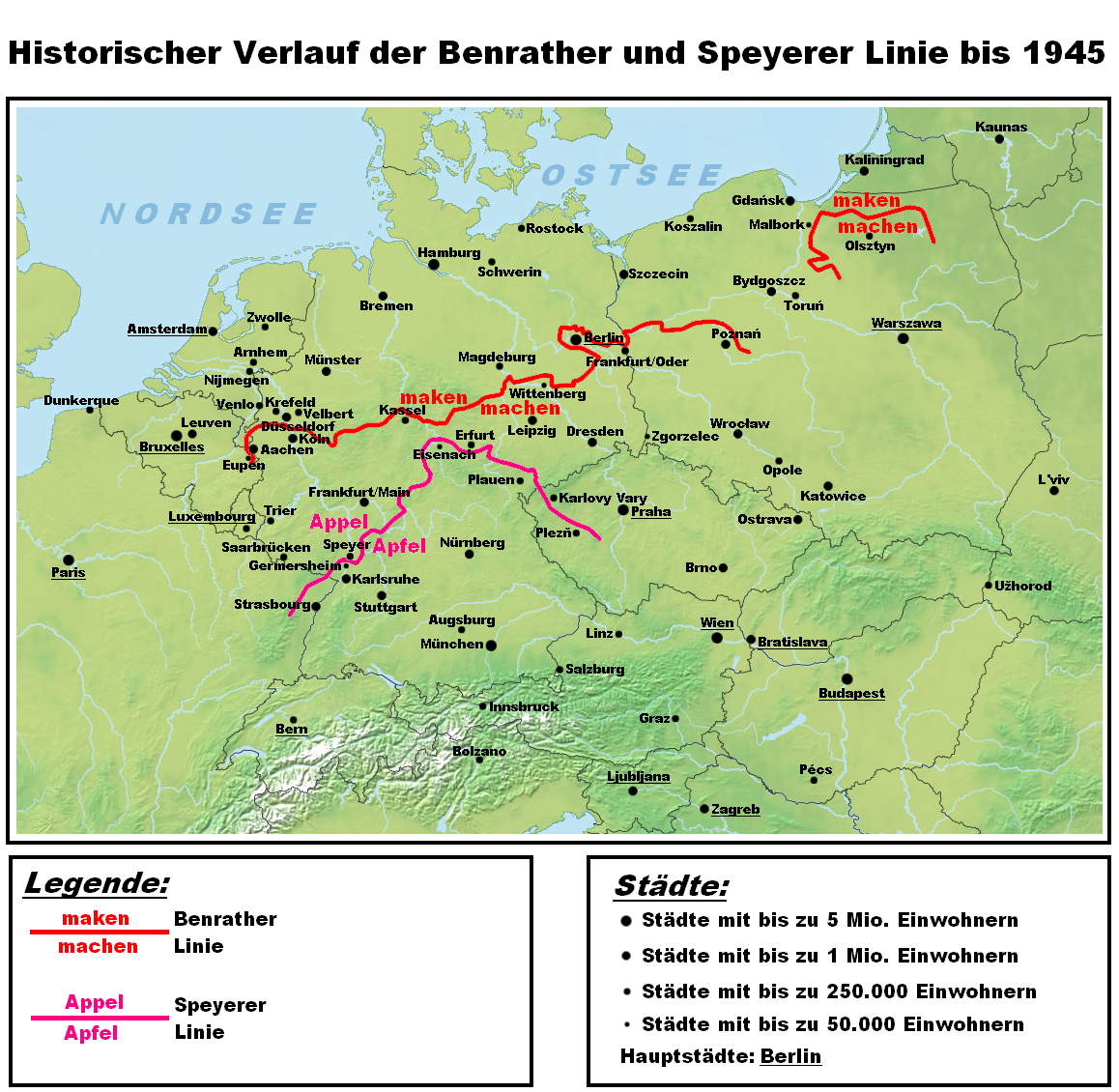Benrath Line on:
[Wikipedia]
[Google]
[Amazon]
 In
In
Varieties of German
German language Isoglosses {{Germanic-lang-stub
 In
In German
German(s) may refer to:
* Germany (of or related to)
**Germania (historical use)
* Germans, citizens of Germany, people of German ancestry, or native speakers of the German language
** For citizens of Germany, see also German nationality law
**Ge ...
linguistics, the Benrath line (german: Benrather Linie) is the ''maken–machen'' isogloss
An isogloss, also called a heterogloss (see Etymology below), is the geographic boundary of a certain linguistic feature, such as the pronunciation of a vowel, the meaning of a word, or the use of some morphological or syntactic feature. Major ...
: dialects north of the line have the original in ''maken'' (to make), while those to the south have the innovative (''machen''). The Line runs from Aachen in the west via Benrath (south of Düsseldorf
Düsseldorf ( , , ; often in English sources; Low Franconian and Ripuarian: ''Düsseldörp'' ; archaic nl, Dusseldorp ) is the capital city of North Rhine-Westphalia, the most populous state of Germany. It is the second-largest city in ...
) to eastern Germany
Germany,, officially the Federal Republic of Germany, is a country in Central Europe. It is the second most populous country in Europe after Russia, and the most populous member state of the European Union. Germany is situated betwee ...
near Frankfurt an der Oder in the area of Berlin
Berlin ( , ) is the capital and largest city of Germany by both area and population. Its 3.7 million inhabitants make it the European Union's most populous city, according to population within city limits. One of Germany's sixteen constitu ...
and Dessau and through former East Prussia dividing Low Prussian dialect and High Prussian dialect. It is called Benrath line because Benrath is the place where it crosses the Rhine
), Surselva, Graubünden, Switzerland
, source1_coordinates=
, source1_elevation =
, source2 = Rein Posteriur/Hinterrhein
, source2_location = Paradies Glacier, Graubünden, Switzerland
, source2_coordinates=
, source ...
.
The High German consonant shift
In historical linguistics, the High German consonant shift or second Germanic consonant shift is a phonological development ( sound change) that took place in the southern parts of the West Germanic dialect continuum in several phases. It probabl ...
(3rd to 9th centuries AD), in which the (northern) Low German dialects for the most part did not participate, affected the southern varieties of the West Germanic dialect continuum
A dialect continuum or dialect chain is a series of language varieties spoken across some geographical area such that neighboring varieties are mutually intelligible, but the differences accumulate over distance so that widely separated vari ...
. This shift is traditionally seen to distinguish the High German varieties from the other West Germanic languages
The West Germanic languages constitute the largest of the three branches of the Germanic family of languages (the others being the North Germanic and the extinct East Germanic languages). The West Germanic branch is classically subdivided into ...
.
The impact of the High German consonant shift increases gradually to the South. The Benrath line does not mark the northernmost effect of the High German consonant shift, since the Uerdingen line
The Uerdingen Line (german: Ürdinger Linie, Uerdinger Linie, nl, Uerdinger linie; named after Uerdingen by Georg Wenker) is the isogloss within West Germanic languages that separates dialects which preserve the ''-k'' sound in the first perso ...
, the ''ik–ich'' isogloss, lies slightly further north; and some of the peripheral changes associated with the shift did affect Low German.
See also
* Speyer line *Uerdingen line
The Uerdingen Line (german: Ürdinger Linie, Uerdinger Linie, nl, Uerdinger linie; named after Uerdingen by Georg Wenker) is the isogloss within West Germanic languages that separates dialects which preserve the ''-k'' sound in the first perso ...
* Joret line
External links
Varieties of German
German language Isoglosses {{Germanic-lang-stub